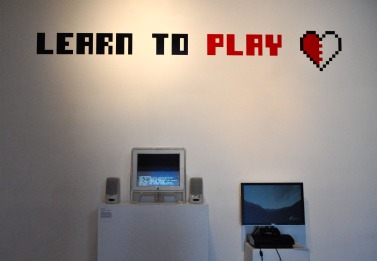 The Euphrat Museum of Art at De Anza College houses interactive games
The Euphrat Museum of Art at De Anza College houses interactive games

An ominous black-and-white ping-pong table screams “mistrust” in large white letters.
Scattered on top are four paddles, each with faces of Barack Obama, Hillary Clinton, and Wen Jiabao.
Chinese and American ping-pong uniforms hang in one corner of the exhibit, next to a TV playing Chinese news.
This is Ping-Pong Diplomacy, the era of shaky relations between China and the United States during Richard Nixon’s presidency.
But unlike the real historical predicament, this exhibit is a game, one of the many in Euphrat Museum of Art’s “Learn to Play” gallery, which opened for the last time on Nov. 24 and will make way for “Learn to Play Too”, the second installment of the gaming series.
The Euphrat Museum, located on the De Anza College campus next to the bookstore, is often overshadowed by the other events at the college but is certainly worth a visit, showcasing different galleries during various times of the year. With art from local artists and De Anza students, the Euphrat Museum embodies the artistic spirit of the community, especially because it is interactive—for the current gallery, guests are free to try out the various games for themselves.
Upon entering, the first thing that draws you in is the cheerful red lettering on the whitewashed wall. “Learn to play,” it declares, complete with a pixelated heart at the end as a friendly gesture. An excellent advantage for students is the lack of an entrance fee—a mere sign-in, and you’re free to explore.
The layout of the museum is very similar to that of the Japanese American Museum of San Jose, in that it is one room with different sections of art and games. The first section has an abstract mural with graffiti, a complement to the game called “Last Resort,” a chess-style game in which “the Bleached side (with nuke) fights to free a foreign people in another land [and] the Oiled side fights to be a free people in their own land.” The board game looks like a wooden chessboard with long pieces, an innovative twist on the classic chess.
One particularly impressive aspect is the back corner of the museum, a somewhat empty but colorful space with posters and photographs. The left side of the exhibit has posters that De Anza students held up as they marched to Sacramento last year in protest of budget cuts. “Cutting school creates fools,” proclaims one, while another says in bold yellow, “Educate us! We are the future!” Other pieces in the exhibit include a Día de Los Muertos (Day of the Dead) altar with small figurines and a collage of cut-outs from “La Voz,” the De Anza College publication.
Because of its small size, 40 minutes to an hour should be enough for a comprehensive tour of the Euphrat. The bright lighting and the whitewashed walls successfully convey a gallery feel and showcase the games and art in their best light.
The museum, with exceptions for “select events,” will be closed until Jan. 3, the launch of Learn to Play Too. For those hunting for a paradise of mind-boggling art and games, the Euphrat will be a fine choice.
{cc-by-sa}





